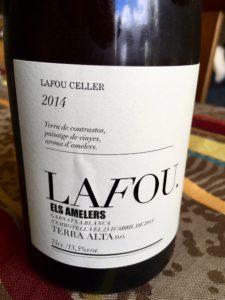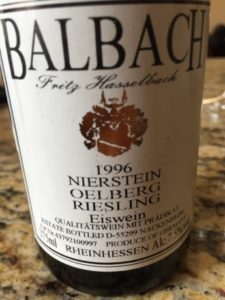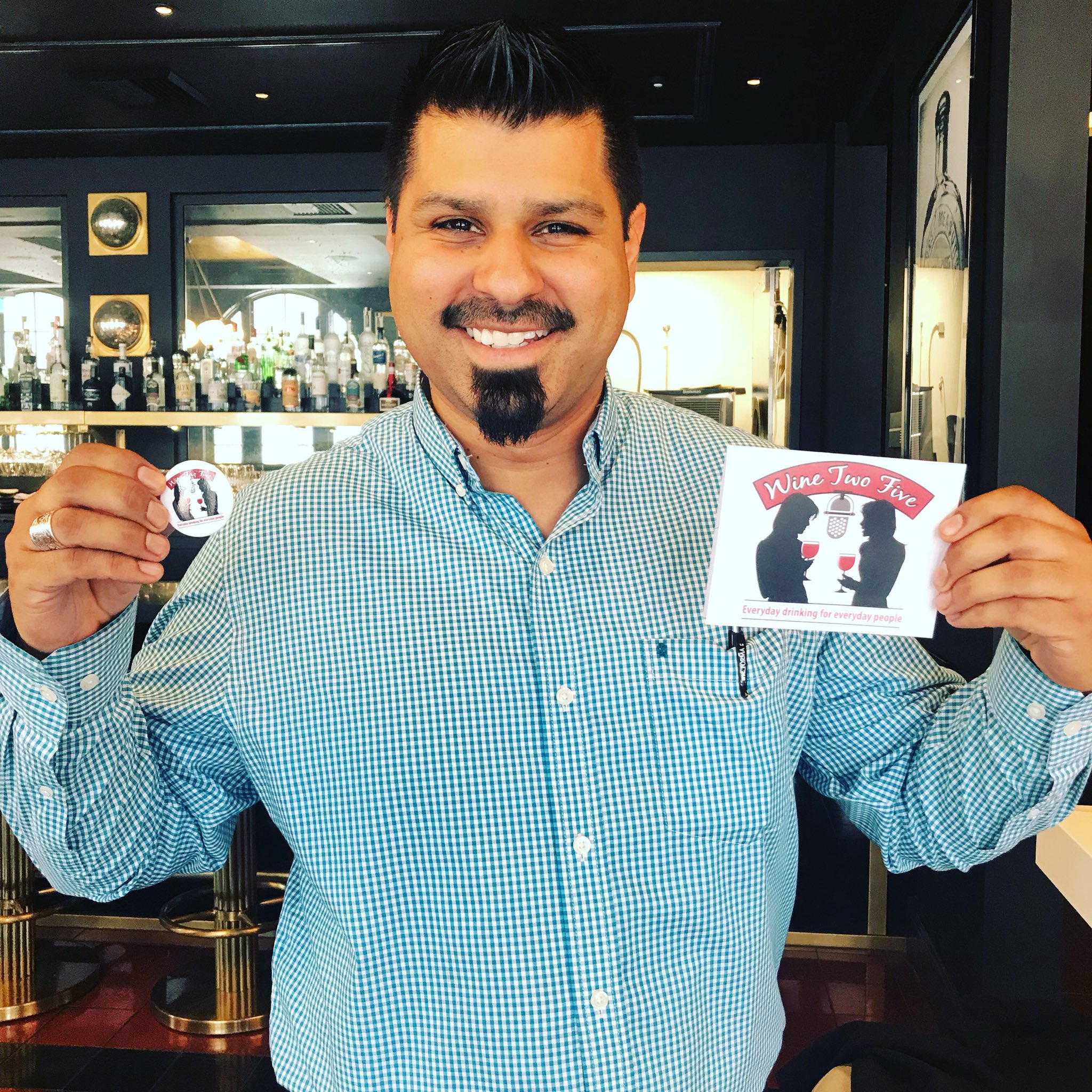Episode 162: Ice Wine and Chill
As the weather warms up, it’s a good time to chill down with some ice wine – or Eiswein – or Icewine. Believe it or not they are not all the same thing. Also, we are announcing the next #W25BookClub book and upcoming educational events.
In Our Glasses (1:10)
Steph:
2015 LaFou Celler “Els Amelers” Garnatxa Blanca from the Terra Alta D.O. (in honor of last week’s little detour to some special Spanish Islands)
Val:
1996 Balbach Riesling Eiswein,Oelberg (vineyard), Nierstein (village), Rheinhessen (Region), Germany by the late Fritz Hasselbach
Why Ice Wine? (5:00)
Because you asked for it. Some time in 2017, our lovely Colorado patron Janet suggested we tackle ice wine as an episode. Good idea, Janet!
And it just so happened that David, in Scotland, posted a #W25Challenge not too long ago and tried ice wine for the first time! It was a Canadian Cabernet Sauvignon Icewine. Way cool!
Wine Two Five listener Lorelai said she loves red ice wine! Her favorite is made from Cabernet Franc grapes.
What it is, and Where it’s Made (6:24)
Ice wine is made from frozen grapes, normally frozen on the vine. Germany and Canada are the leading producers of traditional ice wine, the temperature at harvest is actually regulated. The grapes must reach as low as minus eight degrees Celsius in Canada and minus seven degrees Celsius in Germany before harvesting.
What makes these wines so intensely sweet, treasured, and expensive is the way these wines are made:
- They are pressed while frozen, and because of that, there’s very little juice – about 15% of what you get from table wine grapes.
- The water in the berries is discarded as ice, and the super concentrated (sugar, acid, extracts) juice becomes the exquisite, highly prized wine.
To put it in perspective, to get 1 ml of juice from grapes harvested for table wine, you only need 1 and a half grapes. Just squeeze. But for ice wine? One would need 10 scrunchy, crunchy, little frozen grapes in the dead of the dark, frozen winter.
Ripeness level, harvesting dates, grape varieties and regulations can vary between the countries. Actually, the names are slightly different too.
Eiswein (9:00)
In Germany, ice wine is spelled Eiswein, and is the style’s homeland. The history of Eiswein is fairly recent. It was first documented in the 1800s, but wasn’t commercially produced until the 1960s.
The wine is regulated and has its own Pradikat (QMP) with a required Beerenauslese minimum must weight (110 – 128 Oechsle; or about 26 to a little over 29 degrees for those of you that speak Brix).
Austria also uses the Eiswein spelling, and the grapes must have a must weight of at least 25 degrees, which they measure in KMWs, for those of you that speak Klosterneuberger Mostwaage.
Just for giggles, as promised: 1 degree KMW = 1.2 degrees Brix = 5 degrees Oechsle.
The grapes in Germany and Austria are picked during the first sufficiently freezing November or December days, and often at night or the wee-hours of the morning. Picking in January or February does happen too, but the resulting wine is still vintage labeled according to the growing year.
Icewine (10:35)
In Canada, the picking season is between December and February. The juice from these grapes often have must weight of 35 to 39 degrees Brix!
It’s called Icewine here, and is all one word that is trademarked by the Canadian Vintners Association (CVA). Icewine is a huge deal in this country. Canada is the world’s largest producer of Icewine.
Ontario produces 90% of Canada’s Icewine (about 850L per year), and has made it every single year since 1984; but it’s made in all the wine regions of Canada. British Columbia is also a high quality producer.
Ice Wine (11:40)
Ice wine (generic, two words, no caps) is also made in other wine producing countries including Luxembourg, Switzerland and the US – places like Michigan, New York, Idaho and other states. There is also an iced wine made with Zinfandel in Amador County (Amador Ice, by Renwood), There is also a ridonculous New Zealand ice wine that was a blend of Riesling and Gewurztraminer.
Grapes (13:40)
Can you make ice wine with just any old grape? Pretty much, yes.
While traditional varieties for ice wine are high in aromatics and medium-high in acid. They include Riesling, Vidal Blanc, Gewurztraminer, Sylvaner, Chardonnay and Cabernet Franc.
In Austria you can even find Eiswein from Grüner Veltliner, Zweigelt and other local favorites.
Ideally, the grapes hang on the vine through the winter if birds or boars don’t scavenge them first. While these precious grapes dangle in danger, they dehydrate and concentrate. It’s not just the wild beasts that can destroy a vineyard destined to be ice wine. Weather can be evil and the threat of mold, hail, wind, and rain is very real. And don’t forget diseases. The longer the hang time, the riskier things get.
The “Low Stress” Ice Wine Option (15:45)
Some winemakers don’t bother with all that hang time, weather, and beast burden. They just flat out put their grapes in a freezer. This isn’t allowed in Germany, but these “iced” or “icebox wines” aka frozen-after-harvest ditties are an optional method used in the US and elsewhere, but have to be labeled accordingly.
The grapes are picked when they are super ripe and then put in commercial freezers. Then the grapes undergo what’s called cryogenic extraction. This allows the winemaker to be in total control and produce an iced wine every vintage.
What to Expect in the Glass (16:35)
Ice wines are relatively low in alcohol (the one Val’s drinking in the episode is 7% abv), which is one of the reasons why they make nice aperitifs or digestifs. Certainly they are paired with desserts and often show best with light, fruit driven desserts and sorbets. Why not serve ice wine at brunch with fruit and whipped cream topped waffles? Yes, go there. And yes, please.
#ItsNot5OClockAndWeDontCare
#BreakfastWine
Serve ice wine chilled in a white wine glass to give it room to express itself. We all like a good swirl, so make sure your glass isn’t too, too small. That said, about an ounce and a half to two ounces is considered a serving.
The aromas and flavors of ice wine depend on the grape variety, ripeness level, and country. A Vidal iced wine from Michigan is not going to be like a Zweigelt eiswein from Austria. The hallmark of high quality ice wine is balanced acidity and sugar, focused fruit, layers of silky sweetness and texture and a harmonious, pleasurable experience. You can see why some of these half-bottles have $50 price tags.
Ageability is another calling card of good ice wine. With the concentrated sugar and acid, ice wines can potentially age a long time. As they mature in the bottle though, the fruit starts to fade into the background and the aromatics are less vibrant. The wine changes, but it becomes something new and exciting.
#W25Challenge
Resources & Learn More
Robinson, J., & Harding, J. (2015). The Oxford companion to wine (4th ed). Oxford: Oxford University Press.
Wine Enthusiast Magazine – Ice Wines From Around the Globe
Wino Radar (22:32)
A Killer of a Book Club
#W25BookClub Announcement!
Tangled Vines : Greed, Murder, Obsession, and an Arsonist in the Vineyards of California, by Frances Dinkelspiel. This book was selected by our very first patron Meg in South Dakota, and she will be leading the book discussion in July. So stay tuned for that episode and go buy yourself (or borrow) the book. We all have plenty of time to indulge in the story and share some opinions.
It’s on Audible (www.audible.com), so you don’t even have to read it. You can walk, garden, drive, fold laundry, and listen!
Wine Camp & Other Summer Wine Goodies from SWE!
- SWEbinar Wednesday, May 23 – 7:00 pm central time: Dishing up Dirt, Sizing up Soil – presented by Jane A. Nickles
- 42nd Annual Conference is August 15-17th in the Finger Lakes Region of NY. (WINE CAMP!)
- CWE Study site just launched!
- There is also a “Gewurztraminer Family” webinar in late June, both on Weds & Saturday. Revisit our Gewurztraminer Grape Gab in Episode 159 for Gewurz 101!
- More: http://winewitandwisdomswe.com/swebinars-2/swebinar-schedule/
New Wine App Launch!
This summer we are proud to be announcing a new wine app called My Wine Society. Wine Two Five is scheduled to be the first wine podcast channel – stay tuned, because this is going to be huge!
Shoutouts (27:15)
Thank you to our Patrons – Clay, Andrew, and Ashley – who posted on social media about their new W25 buttons!
For example, we found this guy proudly showing his swag on Twitter:
Patreon Love (27:30)
Thank you to our Patrons who support us on our Patreon crowdfunding platform!
“Riserva Superiore Supporter”
- Robin from Girls Gone Grape
“Riserva Supporter”
- Antti in Georgia!
“TENacious Tasters”
- Jeff E from the award-winning We Like Drinking podcast
- Sebastian of Sassi Italy Tours
- Jen in Maryland (and the world, according to her Instagram feed)
- David and Lisa in Illinois
- Ann Marie in Virginia
“It’s not five o’clock and we don’t care” Listeners
- Meg in South Dakota
- Clay in Arizona
- In California – Jon, Andrew, Aswani
- Chantel in Ontario, Canada
- Mary Lou in Pennsylvania
- Cathie in Georgia
- In Colorado – Chris and Janet, Diane
- In Illinois – Steve, Renee
- Cathey in Tennessee
- Ashley in North Carolina
- Sean in Ohio
“Tastemaker Listeners”
- David in Scotland
- Carole in Kentucky
- Karen in California
- Chip & Karen in Pennsylvania
- Danielle
- Sirena in New York – our newest supporter! Welcome!
Our Patreon page has details www.patreon.com/winetwofivepodcast on how to be entered into our monthly giveaway, exclusive content, and swag.
We just ordered some more of the original T-shirts (we like to say “first edition”) and have more sizes available.
All Patrons at the $2/month or higher donation level are entered into the drawing.
Connect: (29:55)
Between each weekly chat you can find us on the social spaces @WineTwoFive, and we encourage you to join our private FaceBook group called Wine Two Five Community!
And Instagram!
Connect with Val on Twitter @WineGalUnboxed and as Vino With Val on Facebook, Instagram & Pinterest.
Connect with Steph online as @TheWineHeroine.


